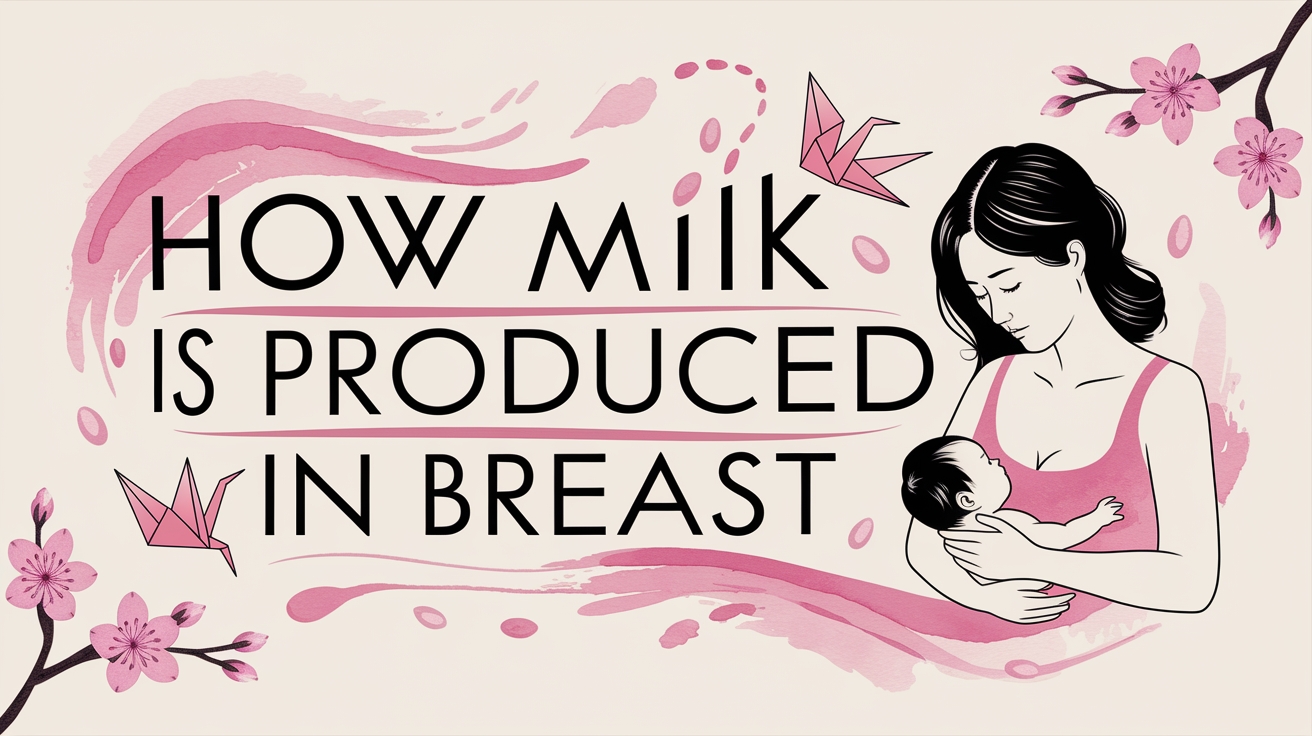Breast milk production is a natural biological process that begins during pregnancy and continues after childbirth. Your body creates milk through a complex system of hormones, glands, and ducts that work together to nourish your baby. Understanding how your breasts produce milk can help you feel more confident about breastfeeding and address any concerns that may arise during your breastfeeding journey.
In this article, you’ll learn about the anatomy of your breasts, the hormones that trigger milk production, and how your body knows exactly how much milk to make for your baby. We’ll also cover common challenges and practical tips to support healthy milk production.

The Anatomy of Milk Production
Your breasts contain specialized structures designed specifically for making and delivering milk:
Mammary Glands: These are the milk-producing factories within your breasts. Think of them as tiny manufacturing plants dedicated to creating the perfect food for your baby.
Alveoli: Within the mammary glands are clusters of small sacs called alveoli. These are where milk is actually produced. Picture them as tiny balloons that fill with milk.
Milk Ducts: These are the delivery pathways that carry milk from the alveoli to your nipple. They work like a network of small rivers flowing toward a main outlet.
Montgomery Glands: These small bumps around your areola produce a natural oil that keeps your nipples clean and protected during breastfeeding.
During pregnancy, your breast tissue undergoes remarkable changes. The number of milk-producing cells increases, and your breasts grow in size as they prepare for their upcoming role.
Hormonal Regulation of Milk Production
Hormones act as chemical messengers that tell your body when to start, maintain, and adjust milk production:
Prolactin: This is the primary milk-making hormone. After birth, when placental hormones drop, prolactin levels rise and signal your breasts to start producing milk. The more your baby feeds, the more prolactin is released, which tells your body to make more milk.
Estrogen and Progesterone: During pregnancy, these hormones prepare your breasts for lactation but actually prevent milk production. After birth, their levels fall dramatically, allowing prolactin to begin working effectively, like removing the brakes from a car.
Oxytocin: Often called the “love hormone,” oxytocin triggers the let-down reflex. When your baby suckles, oxytocin causes the muscles around the alveoli to contract, pushing milk through the ducts to the nipple. This is why you might feel a tingling sensation or notice milk leaking when you hear your baby cry or even just think about them.
Stages of Breast Milk Production
Your breast milk changes in composition over time to meet your growing baby’s needs:
Colostrum: This is your first milk, produced during late pregnancy and the first few days after birth. It’s thick, yellowish, and packed with antibodies and nutrients. Though small in volume (about a teaspoon per feeding), it’s highly concentrated—like a powerful multivitamin for your newborn.
Transitional Milk: Between days 2-5 and day 14 postpartum, your milk transitions from colostrum to mature milk. It contains higher levels of fat, lactose, and calories than colostrum, and its volume increases significantly.
Mature Milk: By about two weeks after birth, your milk has fully matured. It appears thinner and more watery than transitional milk but remains rich in nutrients. Mature milk even changes during a single feeding—starting as watery “foremilk” that quenches thirst and ending with creamy “hindmilk” that satisfies hunger.
Types of Breast Milk
Breast milk is not a one-size-fits-all solution; it evolves to meet your baby’s changing needs. Here are the different types of breast milk and their unique characteristics:
Colostrum: Often referred to as “liquid gold,” colostrum is the first milk produced by the breasts, typically in the first few days after birth. It is rich in antibodies and essential nutrients, providing a powerful immune boost to your newborn.
Transitional Milk: This type of milk appears between 2-14 days postpartum. It is a blend of colostrum and mature milk, offering a balance of nutrients and increased volume to meet your baby’s growing appetite.
Mature Milk: By about two weeks after birth, your milk transitions to mature milk. This is the most abundant type of breast milk, rich in carbohydrates, proteins, and fats, providing all the necessary nutrients for your baby’s growth and development.
Foremilk: Produced at the beginning of a feeding session, foremilk is typically watery and low in fat, perfect for quenching your baby’s thirst.
Hindmilk: As the feeding session progresses, the milk transitions to hindmilk, which is richer in fat and calories, helping to satisfy your baby’s hunger and support healthy weight gain.
Supply and Demand: How Your Body Knows How Much Milk to Make
Your body’s milk production works on a fascinating supply-and-demand basis:
Feedback Inhibitor of Lactation (FIL): Milk contains a protein that acts as a natural regulator. When milk stays in your breast, this protein builds up and signals your body to slow down production. Slow milk production occurs as a natural response to reduced demand from the baby during lactation. When milk is removed through feeding or pumping, levels of this protein drop, and production continues, much like how a factory slows production when inventory builds up and increases when shelves are empty.
Frequent Feeding: The more often your baby feeds, the more milk your body makes. This is why feeding on demand rather than on a strict schedule helps maintain a healthy milk supply.
Signs of Adequate Supply: You can tell your baby is getting enough milk if they:
Have 6-8 wet diapers daily
Gain weight appropriately
Seems satisfied after feeds
Have regular bowel movements
Monitoring Milk Supply
Ensuring your baby is getting enough milk is crucial for their growth and development. Here are some practical ways to monitor your milk supply:
Weight Gain: Regular weight checks can help determine if your baby is gaining weight at a healthy rate. Consistent weight gain is a good indicator that they are getting enough breast milk.
Wet Diapers: A well-fed baby will typically have 6-8 wet diapers per day. This is a reliable sign that they are receiving enough fluids.
Soiled Diapers: Expect 1-2 soiled diapers per day. Regular bowel movements are another indicator that your baby is getting enough milk.
Feeding Frequency and Duration: Monitor how often and how long your baby feeds. Frequent and effective feeding sessions help maintain a healthy milk supply.
Milk Expression: Using a breast pump to express milk can help you gauge your milk supply. If you can express a good amount of milk, it’s a sign that your supply is adequate.
Common Challenges in Milk Production
Even with this well-designed system, challenges can arise:
Low Milk Supply: This can happen for various reasons, including infrequent feeding, poor latch, certain medications, or medical conditions. Most supply issues can be addressed with proper support and techniques.
Oversupply: Some mothers produce more milk than their baby needs, which can lead to engorgement, forceful let-down, and fussy feeding. Strategies like block feeding (using one breast per feeding session) can help manage oversupply.
Poor Attachment: This is the most common cause of sore nipples and can affect milk transfer. When your baby latches properly, their mouth should cover a large portion of the areola, not just the nipple.
Practical Tips to Support Milk Production
These strategies can help maintain healthy milk production:
Proper Latching: Ensure your baby opens wide and takes in a good portion of the areola, not just the nipple. Their lips should be flanged outward, and you should hear rhythmic swallowing.
Feed Frequently: Newborns typically feed 8-12 times per 24 hours. Following your baby’s hunger cues rather than watching the clock helps maintain your supply.
Stay Hydrated and Nourished: Your body needs adequate fluids and calories to produce milk. Keep a water bottle nearby when feeding, and don’t skip meals.
Rest When Possible: Fatigue can affect milk production, so try to rest when your baby sleeps.
Consider a Breast Pump: If you’re separated from your baby or need to increase supply, pumping can help maintain or boost production.
Special Circumstances in Lactation
Sometimes, special approaches to lactation are needed:
Inducing Lactation: Non-birth mothers can stimulate milk production through a combination of hormone therapy, breast stimulation, and milk expression. This process takes time and patience but can be successful.
Relactation: Mothers who have stopped breastfeeding can often restart milk production through frequent stimulation of the breasts, either by a baby or a pump.
Milk Expression Techniques: Learning proper hand expression can be valuable for all breastfeeding mothers. It’s a skill that helps relieve fullness, collect milk, and stimulate production without special equipment.
Breast Milk Composition
Breast milk is a nutritional powerhouse, perfectly tailored to meet your baby’s needs. Here’s a breakdown of its key components:
Carbohydrates: The primary carbohydrate in breast milk is lactose, which provides essential energy for your baby’s growth and development.
Proteins: Breast milk contains proteins like casein and whey, which supply essential amino acids necessary for your baby’s growth and immune function.
Fats: Rich in fatty acids, breast milk provides the energy needed for your baby’s rapid growth and supports the development of their brain and nervous system.
Vitamins and Minerals: Breast milk is packed with vital vitamins and minerals, including vitamin D, calcium, and iron, ensuring your baby gets a well-rounded diet.
Comparison to Other Milks
Breast milk stands out for its unique composition and benefits, but how does it compare to other types of milk?
Cow’s Milk: While cow’s milk is higher in protein and calcium, it is lower in carbohydrates and fats compared to breast milk. It also lacks the antibodies and immune factors found in human milk.
Infant Formula: Designed to mimic breast milk, infant formula provides a balanced diet but cannot replicate the unique antibodies and immune-boosting properties of breast milk.
Goat’s Milk: Similar to cow’s milk, goat’s milk has a different fatty acid profile and is often easier to digest for some babies, but it still lacks the unique benefits of breast milk.
Sheep’s Milk: Rich in nutrients and with a unique fatty acid profile, sheep’s milk is nutritious but not commonly consumed by humans and lacks the specific benefits of human milk.
By understanding the unique properties and benefits of breast milk, you can appreciate the incredible role it plays in your baby’s health and development.
Health Benefits of Breastfeeding
The effort to establish and maintain milk production provides significant benefits:
For Babies:
Protection against infections through antibodies and immune factors
Reduced risk of sudden infant death syndrome
Decreased likelihood of middle ear infections, asthma, and eczema
Better cognitive development
Proper development of the jaw and facial muscles
For Mothers:
Faster recovery from childbirth as oxytocin helps the uterus contract
Reduced postpartum bleeding
Lower risk of breast and ovarian cancers
Potential reduction in the risk of Type 2 diabetes and heart disease
Conclusion
Breast milk production is a remarkable process that showcases the body’s ability to nourish a new life. The intricate system of hormones and breast structures works together to create the perfect food for your baby, adjusting in real-time to meet their changing needs.
Remember that while breastfeeding is natural, it’s also a learned skill for both mother and baby. If you face challenges, reach out to a lactation consultant or healthcare provider who can offer personalized support. Your breastfeeding journey is unique, and understanding how your body produces milk is just the first step in that rewarding experience.








